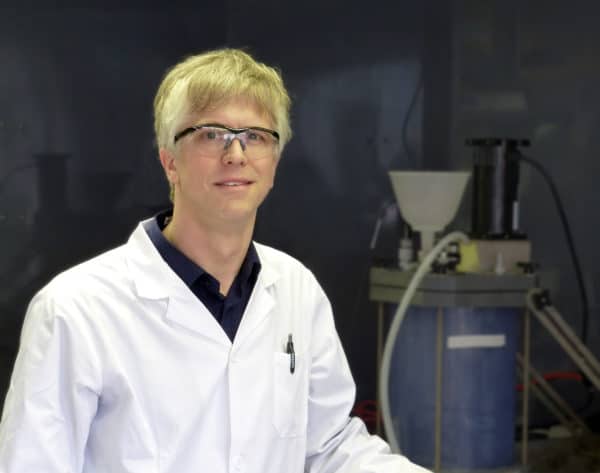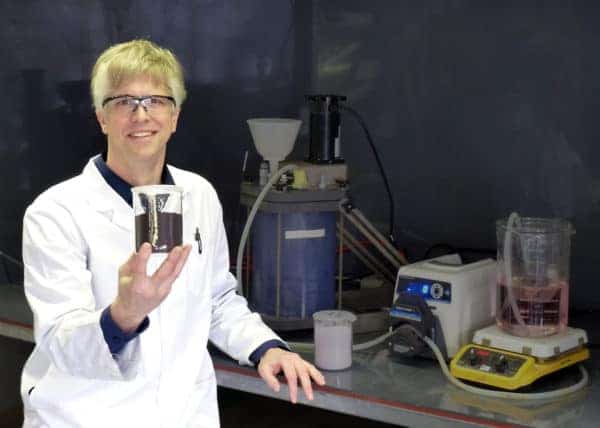Nano One Technologies CEO Dan Blondal talks to Cantech Letter


The battery conundrum. Why does everything in your life seem to get better, faster, and cheaper, but your iPhone still dies at 4pm?
Batteries do not follow Moore’s Law, the observation from Intel co-founder Gordon Moore that the number of transistors on circuit doubles about every two years. The fact is, battery life has gradually improved, but we are also asking these pairings of cathodes and anodes to do much more. The battery in your current smartphone would power a Nokia 8210 for a month, but you can’t play Angry Birds on that phone, and it doesn’t have a GPS enabled map that will get you out of a bad neighbourhood in a hurry.
The implications of battery improvements, of course, extend beyond smartphones into most every aspect of our lives, from cars to generators to the potential to power your home.
Nano One Technologies (Nano One Technologies Stock Quote, Chart, News: TSXV:NNO), which was formed in 2011 and went public last week, has a roster stacked with a deep pedigree of battery expertise. The company’s goal is to reduce the cost of cathode materials in a battery by 50% in terms of dollars per kilowatt hour. Nano One believes it can accomplish this groundbreaking leap through its patent pending processing technology, which assembles particles from the dissolved molecules of raw materials.
Cantech Letter sat down with CEO and founder Dan Blondal to talk about the company’s plan.
Dan, can you explain how Nano One Technologies came to be?
Nano One came to be in 2011 on the back of an idea to transform lithium ion battery performance by changing the way energy storage materials are made. The lithium market was hot, funding came quickly and the scientific team proved the elegant concept in the lab, filed patents and was able to validate preliminary battery performance with outside strategic interests. Fast forward to now and Nano One is partnering with industry to scale the process and to test the outcome on full size batteries.
Your background is vital to the company, can you talk about that?
I’ve been working for 26 yrs as an engineer, much of it in management and as a leader in high growth technology. I’ve been in mining, medical devices, industrial printing, nuclear energy and now electrochemical materials. I like problem solving and I thrive on the challenges of commercialization and market disruption. I also enjoy the details, so I work well across sales, business, management and technology development teams. What I’m most passionate about and really good at, is building stories, brand and vision about the organization, technologies and people behind it all.
We believe that our processing technology can address the cost side of making these materials while also improving energy storage properties. It is a platform technology that could also enable a new generation of energy storage materials that would further transform the world of batteries.
You have said your goal is to reduce the cost of cathode materials by 50% in terms of dollars per kilowatt hour. What ramifications would this have for the industry?
The cathode materials in smart phone and electric car batteries are probably improving by about 2-3% per year in terms of dollars per kilowatt-hour. So it is not hard to see that a 50% improvement would be transformative. We believe that our processing technology can address the cost side of making these materials while also improving energy storage properties. It is a platform technology that could also enable a new generation of energy storage materials that would further transform the world of batteries.
What solutions does the industry use now?
In many cases, the industry mills raw materials into a blend of smaller particles, with repetitive crushing, grinding, blending and firing in a kiln. Other steps might include precipitation or high temperature high pressure processing. Particle size, uniformity and structural integrity are often limited by these techniques, high purity feedstock is typically required and difficulties arise with more sophisticated battery formulations. There are other specialty nanomaterial processes but they are costly and generally inappropriate for high volume production.
How is Nano One Technologies’ solution better than that?
Nano One’s solution for making these materials is simpler, less costly and delivers higher performance materials. Rather than milling to make materials small, we have an innovative way of assembling particles from the dissolved molecules of raw materials. We use simple scalable and cost-effective industrial equipment suited to high volume production. The resulting structures are intimately mixed and this eliminates the need for repetitive milling and prolonged firing of the materials. Our scheme accommodates complex material formulations and has up to 75% fewer steps than rival processes.

What part of the process does Nano One Technologies have a patent on?
We have a dozen patents pending that describe the entire process, from raw materials to finished product, covering methods, equipment, formulations and applications. We continue to innovate and file patents in all of these areas. The core innovation lies in a water-filled reaction vessel that rapidly assembles molecules and controls particle growth in versatile conditions operating at mild temperatures and atmospheric pressure.
Russell Barton has a remarkable engineering track record. What do you think his expertise brings to Nano One Technologies?
Russell brings forty years of engineering and innovation to Nano One. He is as passionate about history as he is about technology, giving him unique insight into centuries of technology know-how. He has deep knowledge in mechanics, fluids and electrochemical systems and he leverages it with a common sense approach that is ever mindful of the economics of commercialization. We are very fortunate to have Russell on board and engaged in Nano One. Nano One also benefits greatly from the leadership of SFU chemistry and nanomaterials professor, Dr Byron Gates and from the partnership with industrial commercialization experts at BC Research and NORAM engineering.
Why do battery advances move so slowly? We read about all sorts of technologies that double or triple their speed and capacity every few years. Yet the battery on our cell phone still seems to be dying at 4pm….
Yes, batteries are slow to improve compared to the electronics that they power. But if it wasn’t for the relentless efficiency gains of semi-conductors, we’d be doing far less with batteries than we are. Leaps in energy storage do occur, but only in spurts when fundamentally new technologies or material formulations can be commercialized. Nano One aims to be one of those leaps and provide battery designers with more latitude to boost charging, cycling and storage in the constant race to add features to our devices and mileage to our vehicles.
Nano One Technologies seems to be set up to keep overhead low. What kinds of costs have you incurred to date and what will it take to bring you to commercialization?
Since 2011, we have spent three million dollars to take an idea from concept to patents pending to outside validation. We’ve just raised another three million as part of an RTO and this should carry us through 2016. We will continue leveraging our treasury through Canadian government granting programs and our two-year goal is to demonstrate scale pilot production and performance in full size batteries. Once cost, scale-up and performance are proven to the outside world, we expect strategic engagement to follow.
We want to license our technology and partner with those that have credibility in sourcing, manufacturing and distributing materials. There are many groups working on specific formulations of materials but we don’t see them so much as competitors, but as potential users or licensees of our process.
Can you talk about the roadmap you have in front of you? What kinds of milestones should investors be looking for?
This phase of our roadmap will have us validating material performance in full size batteries in parallel with the design, construction and demonstration of a materials pilot production line. To compliment these activities, we have embarked on the conceptual design of a commercial production facility to serve strategic interests and to inform the piloting project. Investors can also expect to see us filing more patents, exploring other markets, leveraging Canadian government funding and engaging world leaders in vehicles, electronics, batteries and materials.
Simple question. Can you make a battery last longer?
I get this question all the time and the answer is that it depends. It depends on how smart phone and electric car manufacturers choose to leverage the improvements; they may want it to last longer, charge faster or drive more features; they may want to extend their warranty, improve mileage or reduce the size of battery packs. If we can commercial improvements to battery materials, then rest assured that consumers can benefit in many different ways.
What do batteries really need to take them to a new level?
Ultimately, batteries need longer lasting energy storage materials with higher energy density. There is no shortage of promising energy storage materials, but there is a shortage of ways to cost effectively produce them in large quantities. Nano One believes it has the platform processing technology that can enable a new generation of energy storage materials.
What is your target market looking for from you?
Strategic groups are looking for battery performance, a scalable approach to commercialization and intellectual property that can give them an advantage over their competitors.
Who is your competition?
Our competition is also our target market. We want to license our technology and partner with those that have credibility in sourcing, manufacturing and distributing materials. There are many groups working on specific formulations of materials but we don’t see them so much as competitors, but as potential users or licensees of our process.
How will your patents stand-up to competition?
Early indications from the US and foreign patent office confirm the novelty of our claims and the growth potential in our intellectual property portfolio. Our patent agent, Dr Joe Guy, is also an experienced chemist and as a testament to Nano One’s innovations, Joe has joined the board to advise and support us in leveraging our intellectual property
Why is a licensing model the right path?
The barrier to entry on materials manufacturing should not be underestimated and we believe that partnering and licensing is a faster and more prudent path to commercialization. In markets, where there is large growth, there is also room for process innovations and capital expenditures, because capacity is being ramped up and the players are looking for manufacturing advantages.
Disclosure: Nano One Technologies is an annual sponsor of Cantech Letter
Nick Waddell
Founder of Cantech Letter
Cantech Letter founder and editor Nick Waddell has lived in five Canadian provinces and is proud of his country's often overlooked contributions to the world of science and technology. Waddell takes a regular shift on the Canadian media circuit, making appearances on CTV, CBC and BNN, and contributing to publications such as Canadian Business and Business Insider.

